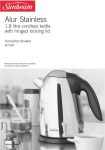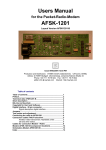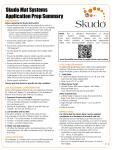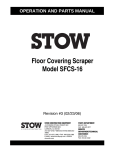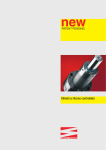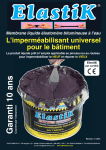Download Special Springs S.r.l.
Transcript
KE 1800 A ÷ KE 18500 A * included in the maintenance kit KE 1800 A ÷ KE 18500 A. ** included in the assembled bushing. Wiper rod** Rod Rod guide** Retaining C-ring Piston guide* Back-up piston seal** Assembled bushig* One way valve Cod. 59VU02* Plug 1/8”G Cod. 39T1/8 (KE12000 A ÷ KE18500 A) Plug M6 Cod. 47THRM6 (KE1800 A ÷ KE7500 A) Rod seal** OSPAS Non self-contained version connecting port. Charging hole suitable for 1/8"G cylinders connections (KE12000 A ÷ KE18500 A) Charging hole suitable for M6 cylinders connections (KE1800 A ÷ KE7500 A) CYLINDERS MAINTENANCE KITS KE1800A KE3000A KE4700A KE7500A KE12000A KE18500A Cod. Cod. Cod. Cod. Cod. Cod. 39BMKE01800A 39BMKE03000A 39BMKE04700A 39BMKE07500A 39BMKE12000A 39BMKE18500A Cod. 39DMA Cod. 39DMCILA The DMA multi device is designed and built to facilitate checking, decreasing/increasing pressure or pressurising self-contained cylinders or hosed systems. It consists of two units: main (DMCILA) and secondary (DMCPVA). Multi device for charging, discharging and adjust gas pressure. Cod. 39DMCPVA Charging set including 3 meters of high pressure hose, 1 female Cejn quick fit, 1 ON/OFF valve, 1 shut off valve and 1/2-20 UNF male coupling to connect to the nitrogen bottle. NOTE: It is included in the 39DMA case. Cod. 58CE03 for M6 thread Cod. 58CE05 for 1/8G thread Hex T-key to remove charging hole plug and valve retaining screw. Cod. DDS - 1/8G for KE12000 A ÷ KE18500 A Cod. DDS - M6/3 for KE1800 A ÷ KE7500 A Discharging device. Cod. 58KNIPEX Retaining C-Ring removal tool. Multipurpose pliers with spouts. Special Springs along with its own global network are pleased to help you anytime for the best result of your work. Cod. 58CC... Before starting any maintenance work, carefully check if the rod or the body of the cylinder are damage or wear. If yes, it is recommended to replace the cylinder immediatley and do not procede with the maintenance operation. Compass key with plugs to remove the rod top cap. T-handle to remove piston-rod + bushing. Cod. 58CC03 KE3000A ÷ KE18500A Cod. 58CC02 KE1800A Cod. 49TB026.5 (mod. KE1800A) Cod. 49TB035.5 (mod. KE3000A) Cod. 49TB048.5 (mod. KE4700A) Cod. 49TB061.5 (mod. KE7500A) Cod. 49TB081.5 (mod. KE12000A) Cod. 49TB106.5 (mod. KE18500A) Reassembly guiding tube for the bushing + reassembly positioning tube for the retaining C-ring. KE1800A) KE3000A) KE4700A) KE7500A) KE12000A) KE18500A) Before starting any maintenance work carefully check the maintenance kit to correspond to the model of cylinder for which is required. NITROGEN GAS CYLINDERS MAINTENANCE KE1800A ÷ KE18500A Marked OSPAS Before starting any maintenance work carefully check this step-by-step manual to correspond to the model of cylinder for which is requied. Instructions and pictures of this step-by-step manual could slightly differ from practise. EYE (mod. (mod. (mod. (mod. (mod. (mod. Cejin male quick fit adapter for direct charging. P R OT E C N 49TN032 49TN045 49TN055 49TN070 49TN088 49TN120 Cod. 39QDFV01 for KE1800A ÷ KE7500A Cod. 39QDFV02 for KE12000A ÷ KE18500A TIO Cod. Cod. Cod. Cod. Cod. Cod. NOTE: It is included in the 39DMA case. The complete assembled kit along with this step-by-step service manual is result of Special Springs research for the most useful manteniance operation for Special Springs nitrogen gas cylinders. Few minutes and the Special Springs nitrogen gas cylinders are regenerated as new one. Cod. 58EAR Cod. 58EM06 for M6 thread Cod. 58EM08 for M8 thread Body Anti scratch nylon tube to set the bushing into the cylinder body to release the retaining C-ring. Cod. 39RFG Cod. 39PM01 Special Springs gas detector for easy gas leakage. Table manual press for easy and safe positioning of components. All Special Springs step-by-step manuals are available for download from our web site: www.specialsprings.com Cod. 58CD01 Torque wrench for KE series one way valve. 9801C03002110 © All right reserved. Special Springs S.r.l. via Brega, 216 36027 Rosà (VI) ITALY Tel ++39 0424 539181 Fax ++39 0424 898230 [email protected] www.specialsprings.com I. SKUDO REMOVAL. II. DISCHARGING + VALVE REMOVAL for self-contained cylinders. 1. Manually remove the protective cap SKUDO. Do not use tools. For certain models the operation will require a certain strain. Preserve the protective cap SKUDO for further reassembly. 2. Remove the protective screw cap from the charging hole by using the appropriate tool. 58CE05 for the 1/8 G port. 58CE03 M6/3 for the M6 port. 3. Thread DDS bleed device on the charging port then exhaust completely the pressure. Point away from the operator for maximum safety. DDS-1/8G for the 1/8 G port. DDS-M6/3 for the M6 port. 4. Hang and release the one way valve from the hole by using the appropriate tool. It would be normal some oil leak from the hole when upside down the cylinder. 58CD01 one way valve removingsetting dynamometric wrench. XII. REASSEMBLY OF THE UPPER RING NUT 27.Insert the positioning tube in contact with the retaining C-ring , then by the manual press, press down the retaining C-ring into the groove. When the C-ring enter correctly into the groove you will hear a loud like “CLICK”. 49TB… conical centring guide tube. 39PM01 manual press. 28. Manually extract the assembly piston-rod/cartridge completely. 58EM04 T-handle M4. 58EM06 T-handle M6. 58EM08 T-handle M8. 29. Cut off with all components correctly assembled. 30. Position and thread the upper ring nut of the cylinder by using the appropriate compass wrench. 58CC… compass wrench. 32. Position the safety device OSPAS into the proper hole located in the cylinder bottom. It is severely forbidden to press the piston-rod into the body when the safety device OSPAS is positioned. High risk to damage and compromise the functional of the safety device. 33. lock up the safety device by using the appropriate tool. 58CE05 hex key. XIII. POSITIONING OF OSPAS + OIL LUBICATION. III. OSPAS REMOVAL. Model 750 1000 1800 3000 4700 7500 12000 18500 Oil volume 1,5 ml 2 ml 3 ml 4 ml 5 ml 8 ml 15 ml 30 ml NOTE: Each oil dispenser contains a volume of 5 ml. 5. It is severely forbidden to press down the piston-rod into the cylinder body before removing the safety device OSPAS. High risk of damaging and compromise the regular function of the safety device. 6. To remove the safety device OSAPS it is necessary to remove first the aluminium seal from the hex hole of the screw. Use the special drill hit, included in the maintenance kit, and mount it on a small hand drill. 7. The hex hole will be then completely free and ready to be used. IV. DISCHARGING non self-contained cylinders. 8. Remove the safety device OSAPS by using the appropriate tool and take it away from the hole. Preserve the safety device OSAPS for further reassembly. 58CE05 hex key. 31. Upside-down the cylinder and drop the lubricating oil supplied with the kit. Please do not exceed the volumes as indicated in the tab. V. UPPER RING NUT REMOVAL. XIII. CHARGING AND FORCE TEST self container cylinders. A. For hosed cylinders exhaust pressure through the bleed valve on the control panel. When completely exhausted the gauge on the panel will display 0 (zero) pressure. Then disconnect all cylinders from hoses and fitting. B. Repeat then the procedure as above indicated at points 1,2,3,4,5,6,7,8,9. 9. ONLY after the safety device OSPAS has been removed the piston rod can be pressed down into the cylinder body. 10. Remove the upper ring nut on the body by using the appropriate wrench. 58CC… compass wrench. 34. Once re-positioned the OSPAS device set the aluminum seal on the hexagonal hole and smash it. It is severely forbidden to press the piston-rod into the body when the safety device OSPAS is positioned. High risk to damage and compromise the functional of the safety device. 35. Check the correct assembly of the pressare regulation valve on the gas bottle, then open the main tap. The gauge on the left will indicate the bottle pressure. 39RP pressure regulation valve. 36. Adjust the required maximum pressure trought the regulation valve. The gauge on the right will indicate the maximum allowed pressure to charge the cylinder. 39RP pressure regulation valve. 37. Select and assemble the desired charging adapter and thread it on the charging port. For an easy and safety work carefully follow the instructions supplied with the charging unit. DO NOT exceed the maximum pressure indicated for any specific model. 39DMA charging unit. 14. Remove the retaining C-ring by using the appropriate removal tool and pincer. Preserve the retaining C-ring for further reassembly. 58EAR C-ring removal tool. 58KNIPEX pincer. 38. Rached and stabilized the desired pressure, for an easy and safety work carefully follow the instructions supplied with the charging unit. 39DMA charging unit. 39. When directly charging throught the adapter and desired pressure is reached shut off the hose and bottle valves and disconnect the the quick fit coupling. For an easy and safety work carefully follow the instructions supplied with the charging unit. 39DMCPVA charging unit. 39QDFV… adapter for direct charging. 40. Unthread and relase the adapter from the charging hole. 41. More precise force control can be carried out by using the digital force testing rigs. FT4700 for initial forces up to 5000 daN. IPCDIG for initial forces up to 20000 daN. 42. It is always recommended to check leaks on the charging port after the maintenance work and before re-using the cylinders by using the special gas detector. 39RFG Special Springs gas detector. 42.1. It is always recommended to check leaks on the upper side of the cylinders after the maintenance work and before re-using the cylinders by using the special gas detector. 39RFG Special Springs gas detector. 43. thread the protective screw into the charging hole by using the appropriate tool. 58CE05 for 1/8G charging port. 58CE03 for M6 charging port. 44. After the charging operation it is recommended to double check the right locking of the upper ring nut on the body by using the appropriate compass wrench. 58CC… compass wrench. VI. RETAINING RING REMOVAL. 11. Position the anti scratch nylon removal tube on the cartridge then press down into the body for about 25 mm to set free the retaining C. 39PM01 manual press. 49TN… nylon removal tube. 12. Cylinder section with piston/rod and cartridge completely pressed into the body. The retaining C-ring result free. 13. Position and clamp the cylinder into a self - centring chuck or a wise. VII. PISTON ROD + CARTRIDGE REMOVAL. VIII. CLEANING AND INSPECTION. 15. Manually extract together piston/rod/cartridge from the cylinder body. It would be required some strain for certain models. 58EM04 T-handle M4 thread. 58EM06 T-handle M6 thread. 58EM08 T-handle M8 thread. 17. Carefully check and clean the cylinder body. If the body show any wear or damage do not use it again and replace it with a new one. 16. Slide off the cartridge from the rod and remove seal and guide from the piston. Discard all of them. IX. VALVE REASSEMBLY. 19. Carefully clean the lodging hole of the valve with an airgun and then position the new one way valve supplied along with the maintenance kit. Be care on the right position of it. 20. Position and thread the one way valve into the hole by using the appropriate special dynamometric tool. Torque force required maximum 0,6 Nm. Do not exceed the maximum torque force indicated to not damage the one way valve. 58CD01 dynamometric wrench. X. REASSEMBLY OF PISTON ROD + CARTRIDGE. XIV. CHARGING AND FORCE TEST for non self-contained cylinders. 21. Assembly into the proper groove the new guide and the new piston seal. Pay the best attention to not damage the seal as well as to the right positioning. 22. Grease all over inside the cartridge with the special grease supplied with the kit and manually press the pre-assembled cartridge into the rod and slide down to the piston shoulder. Pay the best attention to the right orientation of the cartridge. A. After positioning and hosing all the cylinders, proceed through the quick fit device trough the control panel for charging all the cylinders. 39DMCPVA control panel charging unit. 26. Position the retaining C-ring into the conical centring guide tube. E. It is always recommended to check leaks on the upper side of the cylinders by using the special gas detector. 39RFG Special Springs gas detector. XI. REASSEMBLY OF THE RETAINING C-RING. 23. Grease all over around the cartridge, the guide and the seal with the special grease supplied with the kit. 24. Position the conical centring guide tube on the top side of the cylinder body, then position the piston/rod/cartridge into the tube and assure to keep all perpendicular to the tube itself and the cylinder body. 49TB… conical centring guide tube. 18. Carefully check and clean the piston-rod. If the piston rod shows any damage, wear or scratch do not use it again and replace it with a new one. 25. Insert the positioning tube over the rod in contact with the upper side of the cartridge, then by the manual press, press down into the cylinder body all the assembled parts. 49TB… conical centring guide tube. 39PM01 manual press. B. Adjust the required pressure on the regulation valve on the bottle. The gauge on the right will indicate the maximum allowed pressure to charge the cylinders. C. Connect the female quick fit on the male quick fit on the panel and open the gas tap. For an easy and safety work carefully follow the instructions supplied with the charging unit. 39DMCPVA control panel charging unit. D. It is always recommended to check leaks on all connection to and from the cylinder by using the special gas detector. 39RFG Special Springs gas detector. XV. SKUDO REASSEMBLY. 45. After the charging operation it is recommended to double check the right docking of the upper ring nut on the body by using the appropriate compass wrench. 58CC… compass wrench. 46. Manually reassembly the protective cap SKUDO on the proper groove on the top of the rod. It would be required a light pressure to correctly position it. When the protective cup SKUDO enter correctly into the groove you will hear a loud like “CLICK”. 9801C03002110


